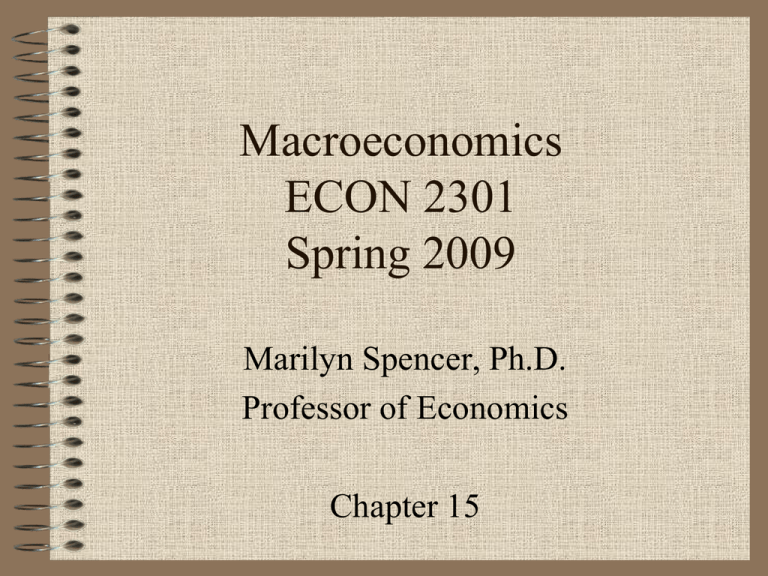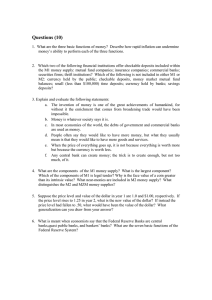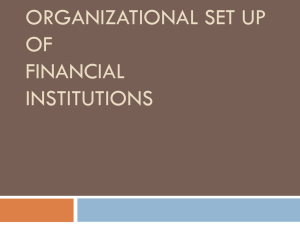Macroeconomics ECON 2301 Spring 2009 Marilyn Spencer, Ph.D.
advertisement

Macroeconomics ECON 2301 Spring 2009 Marilyn Spencer, Ph.D. Professor of Economics Chapter 15 Chapter 15: Money, Banking, and Central Banking Learning Objectives Define the fundamental functions of money Identify key properties that any goods that function as money must possess Explain official definitions of the quantity of money in circulation Understand why financial intermediaries such as banks exist Describe the basic structure of the Federal Reserve System Discuss the major functions of the Federal Reserve 15-3 Money Money Any medium that is universally accepted in an economy both by sellers of goods and services and by creditors as payment for debts 15-4 Table 15-1 Types of Money 15-5 The Functions of Money The 4 functions of money 1. Medium of exchange 2. Unit of accounting 3. Store of value (purchasing power) 4. Standard of deferred payment 15-6 The Functions of Money (cont'd) Medium of Exchange Any item that sellers will accept as payment Barter The direct exchange of goods and services for other goods and services without the use of money 15-7 The Functions of Money (cont'd) Medium of exchange Money facilitates exchange by reducing transaction costs associated with means-ofpayment uncertainty. • Permits specialization, facilitates efficiencies Barter Simply a direct exchange • Double coincidence of wants 15-8 The Functions of Money (cont'd) Unit of Accounting A measure by which prices are expressed The common denominator of the price system A central property of money 15-9 The Functions of Money (cont'd) Store of Value The ability to hold value over time A necessary property of money Money allows you to transfer value (wealth) into the future. 15-10 The Functions of Money (cont'd) Standard of Deferred Payment A property of an item that makes it desirable for use as a means of settling debts maturing in the future An essential property of money 15-11 Liquidity Liquidity The degree to which an asset can be acquired or disposed of without much danger of any intervening loss in nominal value and with small transaction costs Money is the most liquid asset. 15-12 Figure 15-1 Degrees of Liquidity 15-13 Liquidity (cont'd) Question What is the cost of holding money (its opportunity cost)? Answer It is the alternative interest yield obtainable by holding some other asset. 15-14 Monetary Standards, or What Backs Money Questions What backs money? Is it gold, silver, or the federal government? Answer Your confidence 15-15 Monetary Standards, or What Backs Money (cont'd) Transactions Deposits Checkable and debitable account balances in commercial banks and other types of financial institutions, such as credit unions and mutual savings banks Any accounts in financial institutions on which you can easily transmit debit-card and check payments without many restrictions 15-16 Example: E-Gold Backed EMoney The Internet has served as a breeding ground for various forms of e-money. Gold-backed e-money effectively provides measures of the purchasing power, in terms of gold, of several major world currencies. 15-17 Monetary Standards, or What Backs Money (cont'd) Fiduciary Monetary System A system in which currency is issued by the government and its value rests on the public’s confidence that it can be exchanged for goods and services The Latin fiducia means “trust” or “confidence.” 15-18 Monetary Standards, or What Backs Money (cont'd) Currency and transactions deposits are money because of their Acceptability Predictability of value 15-19 Defining Money Money is important Changes in the rate at which the money supply increases or decreases affect important economic variables (at least in the short run) such as inflation, interest rates, employment, and the level of real GDP. Money Supply The amount of money in circulation 15-20 Defining Money (cont'd) Economists use two basic approaches to define and measure money. The transactions approach The liquidity approach 15-21 Defining Money (cont'd) Transactions Approach A method of measuring the money supply by looking at money as a medium of exchange Liquidity Approach A method of measuring the money supply by looking at money as a temporary store of value 15-22 Defining Money (cont'd) The transactions approach to measuring money: M1 Currency Checkable (transaction) deposits Traveler’s checks not issued by banks 15-23 Figure 15-2 Composition of the U.S. M1 and M2 Money Supply, 2007, Panel (a) 15-24 Figure 15-2 Composition of the U.S. M1 and M2 Money Supply, 2007, Panel (b) 15-25 Defining Money (cont'd) M1 Currency • Minted coins and paper currency not deposited in financial institutions • The bulk of currency “in circulation” actually does not circulate within the U.S. borders. 15-26 Figure 15-3 The Value of U.S. Currency in Circulation Outside the United States 15-27 Defining Money (cont'd) M1 Transactions deposits • Any deposits in a thrift institution or a commercial bank on which a check may be written or debit card used Thrift Institution • Financial institutions that receive most of their funds from the savings of the public 15-28 Defining Money (cont'd) M1 Traveler’s Checks • Financial instruments purchased from a bank or a nonbanking organization and signed during purchase that can be used as cash upon a second signature by the purchaser 15-29 Defining Money (cont'd) The liquidity approach to measuring money: M2 Near Moneys Assets that are almost money Highly liquid Easily converted to cash Time deposits are an example 15-30 Defining Money (cont'd) The liquidity approach: M2 is equal to M1 plus 1. Savings and small denomination time deposits 2. Balances in retail money market mutual funds 3. MMDAs 15-31 Defining Money (cont'd) M2 Savings Deposits • Interest-earning funds that can be withdrawn at any time without payment of a penalty Depository Institutions • Accept deposits from savers and lend those funds out 15-32 Defining Money (cont'd) M2 Money Market Deposit Accounts (MMDAs) • Accounts issued by banks yielding a market rate of interest with a minimum balance requirement and a limit on transactions • They have no minimum maturity 15-33 Defining Money (cont'd) M2 Time Deposit • A deposit in a financial institution that requires notice of intent to withdraw or must be left for an agreed period • Early withdrawal may result in a penalty CD • Time deposit with fixed maturity 15-34 Defining Money (cont'd) M2 Money Market Mutual Funds • Funds obtained from the public that investment companies hold in common • Funds used to acquire short-maturity credit instruments – CD’s, U.S. government securities 15-35 Defining the U.S. Money Supply Question Which definition of money correlates best with economic activity? Answer M2, although some businesspeople and policymakers prefer MZM 15-36 Defining Money (cont'd) MZM (money-at-zero-maturity) MZM entails adding deposits without set maturities to M1. MZM includes all MMFs but excludes all deposits with fixed maturities. 15-37 Financial Intermediation and Banks Most nations have a banking system that encompasses two types of institutions. 1. One type consists of private banking institutions. 2. The other type of institution is a central bank. 15-38 Financial Intermediation and Banks (cont'd) Central Bank A banker’s bank, usually an official institution that also serves as a country’s treasury’s bank Central banks normally regulate commercial banks. 15-39 Financial Intermediation and Banks (cont'd) Direct finance Individuals purchase bonds from a business Indirect finance Individuals hold money in a bank The bank lends the money to a business 15-40 Financial Intermediation and Banks (cont'd) Financial Intermediation The process by which financial institutions accept savings from businesses, households, and governments and lend the savings to other businesses, households, and governments 15-41 Figure 15-4 The Process of Financial Intermediation 15-42 Financial Intermediation and Banks (cont'd) Question Why might people wish to direct their funds through a bank instead of lending directly to a business? Answers Asymmetric information Adverse selection Moral hazard Larger scale and lower management costs 15-43 Financial Intermediation and Banks (cont'd) Asymmetric Information Information possessed by one party in a financial transaction but not by the other Adverse Selection The likelihood that borrowers may use their borrowed funds for high-risk projects 15-44 Financial Intermediation and Banks (cont'd) Moral Hazard The possibility that a borrower might engage in riskier behavior after a loan has been obtained Larger scale and lower management costs People can pool funds in an intermediary, reducing costs, risks. Pension funds and investment companies are examples. 15-45 Announcement We will NOT hold class Tues., April 21. Instead, here is an opportunity for 4 points of extra credit: Attend the Kirkland Lecture in the Performing Arts Center at 9:30 a.m. that morning. Be sure to sign in before entering the auditorium. Write a summary of the speaker’s remarks, 50-100 words, and email it to me at marilyn.spencer@tamucc.edu BEFORE class, April 28. Financial Intermediation and Banks (cont'd) Liabilities Amounts owed The sources of funds for financial intermediaries Assets Amounts owned The uses of funds by financial intermediaries 15-47 Table 15-2 Financial Intermediaries and Their Assets and Liabilities 15-48 Financial Intermediation and Banks (cont'd) Payment Intermediaries Institutions that facilitate transfers of funds between depositors who hold transactions deposits with those institutions 15-49 Figure 15-5 How a Debit-Card Transaction Clears 15-50 Financial Intermediation and Banks (cont'd) Capital Controls Legal restrictions on the ability of a nation’s residents to hold and trade assets denominated in foreign currencies International Financial Intermediation Financing investment projects in more than one country 15-51 Table 15-3 The World’s Largest Banks 15-52 Financial Intermediation and Banks (cont'd) World Index Fund A portfolio of bonds issued in various nations whose individual yields generally move in offsetting directions, thereby reducing the overall risk of losses 15-53 Banking Structures Throughout the World The ways that banks around the world differ Size • United States has banks of various sizes • Europe and Japan have a few large banks Legal • Universal banking • Limits on financial services such as insurance and bank stock ownership Importance in financial system • Major importance • Part of a varied financial system (United States) 15-54 Banking Structures Throughout the World (cont'd) Universal Banking An environment in which banks face few or no restrictions on their powers to offer a full range of financial services and to own shares of stock in corporations 15-55 Banking Structures Throughout the World (cont'd) Central banks and their roles 1. Perform banking functions for their nations’ governments 2. Provide financial services for private banks 3. Conduct their nations’ monetary policies 15-56 The Federal Reserve System The Fed The Federal Reserve System; the central bank of the United States The most important regulatory agency in the U.S. monetary system Established in 1913 by the Federal Reserve Act 15-57 The Federal Reserve System (cont'd) Organization of the Fed Board of Governors • 7 members, 14-year terms Federal Reserve Banks (12 Districts) • 25 branches Federal Open Market Committee (FOMC) • BOG plus 5 presidents of district banks 15-58 Figure 15-6 Organization of the Federal Reserve System 15-59 Figure 15-7 The Federal Reserve System 15-60 The Federal Reserve System (cont'd) Depository institutions 7,500 commercial banks 1,300 savings and loans 11,000 credit unions All may purchase Fed services 15-61 The Federal Reserve System (cont'd) Functions of the Fed 1. Supplies the economy with fiduciary currency 2. Provides a payment-clearing system 3. Holds depository institutions’ reserves 4. Acts as the government’s fiscal agent 5. Supervises depository institutions 6. Acts as a “lender of last resort” 7. Regulates the money supply 15-62 Issues and Applications: Check Clearing—A Rapidly Diminishing Fed Function The volume of checks cleared by the Fed grew rapidly during the 1980s. So why has the Fed’s check clearing speed dropped since the 1990s? 15-63 Issues and Applications: Check Clearing—A Rapidly Diminishing Fed Function (cont'd) The reason is not due to inefficiency; rather, checks are falling out of favor. Government transfers are transmitted electronically—Social Security, Medicare, Medicaid. Electronic payments by households and businesses—debit cards, Internet bill pay, Web based services. 15-64 Figure 15-8 The Volume and Value of Federal Reserve Check Clearings Since 1985 15-65 Summary of Learning Objectives The key functions of money 1. Medium of exchange 2. Unit of accounting 3. Store of value 4. Standard of deferred payment Important properties of goods that serve as money Acceptability, confidence, and predictable value 15-66 Summary of Learning Objectives (cont'd) Official definitions of the quantity of money in circulation M1: the narrow definition, focuses on money’s role as a medium of exchange M2: a broader one, stresses money’s role as a temporary store of value 15-67 Summary of Learning Objectives (cont'd) Why financial intermediaries such as banks exist Asymmetric information can lead to adverse selection and moral hazard problems Savers benefit from the economies of scale The basic structure of the Federal Reserve System 12 district banks with 25 branches Governed by Board of Governors Federal Open Market Committee 15-68 Summary of Learning Objectives (cont'd) Major functions of the Federal Reserve Supply the economy with currency Provide systems for transmitting and clearing payments Holding depository institutions’ reserves Acting as the government’s fiscal agent Supervising banks Acting as a “lender of last resort” Regulating the money supply Intervening in foreign exchange markets 15-69 Learning Objectives: Explain how federal government budget deficits occur Define the public debt and understand alternative measures of the public debt Evaluate circumstances under which the public debt could be a burden to future generations Discuss why the federal budget deficit might be measured incorrectly Analyze the macroeconomic effects of government budget deficits Describe possible ways to reduce the government budget deficit 14-70 Public Deficits and Debts: Flows versus Stocks Government Budget Deficit Exists if the government spends more than it receives in taxes during a given period of time Is financed by the selling of government securities (bonds) 14-71 Public Deficits and Debts: Flows versus Stocks (cont'd) The federal deficit is a flow variable, one defined for a specific period of time, usually one year. If spending equals receipts, the budget is balanced. If receipts exceed spending, the government is running a budget surplus. 14-72 Public Deficits and Debts: Flows versus Stocks (cont'd) Balanced Budget A situation in which the government’s spending is exactly equal to the total taxes and revenues it collects during a given period of time Government Budget Surplus An excess of government revenues over government spending during a given period of time 14-73 Public Deficits and Debts: Flows versus Stocks (cont'd) Public Debt A stock variable The total value of all outstanding government securities 14-74 Government Finance: Spending More than Tax Collections Since 1940, the U.S. federal government has operated with a budget surplus in 13 years. In all other years, the shortfall of tax revenues below expenditures has been financed with borrowing. 14-75 Figure 14-1 Federal Budget Deficits and Surpluses Since 1940 14-76 Figure 14-2 The Federal Budget Deficit Expressed as a Percentage of GDP 14-77 Policy Example: Explaining a $109 Billion Deficit Projection Turnaround Why was the government’s 2005 deficit projection off by $109 billion? Federal tax revenues turned out to be more than 15% higher in 2005. Economic growth caused taxable incomes, hence revenues, to be much higher than anticipated. 14-78 Evaluating the Rising Public Debt Gross Public Debt All federal government debt irrespective of who owns it Net Public Debt Gross public debt minus all government interagency borrowing 14-79 Evaluating the Rising Public Debt (cont'd) Some government bonds are held by government agencies. In this case, the funds are owed from one branch of the federal government to another. To arrive at the net public debt, we subtract interagency borrowings from the gross public debt. 14-80 Evaluating the Rising Public Debt (cont'd) Tax revenues tend to be stagnant during times of slow economic growth. Tax revenues grow more quickly when overall growth enhances incomes. As long as spending exceeds revenues, the budget deficit will persist. 14-81 Table 14-1 The Federal Deficit, Our Public Debt, and the Interest We Pay on It 14-82 Figure 14-3 Net U.S. Public Debt as a Percentage of GDP 14-83 Net U.S. Public Debt as a Percentage of GDP During World War II, the net public debt grew dramatically. After the war It fell until the 1970s Started rising in the 1980s Declined once more in the 1990s And recently has been increasing again 14-84 Assignment to be completed before class April 21: Read Chapter 16 & also read the end-of-chapter Problems: 16-1, 16-2, 16-4, 16-7, 16-9, 16-12 & 16-15, on pp. 420-421.





